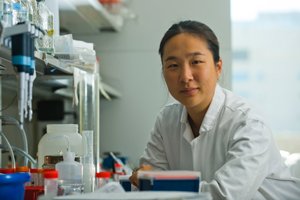Dec 8 2009
One of the promises of nanomedicine is the design of tiny particles that can home in on diseased cells and get inside them. Nanoparticles can carry drugs into cells and tag cells for MRI and other diagnostic tests; they may eventually even enter a cell's nucleus to repair damaged genes. Unfortunately, designing them involves as much luck as engineering.
 Rice's Junghae Suh has created a new method to track nanoparticles in living cells. Image: JEFF FITLOW
Rice's Junghae Suh has created a new method to track nanoparticles in living cells. Image: JEFF FITLOW
"Everything in nanomedicine right now is hit-and-miss as far as the biological fate of nanoparticles," said Rice University bioengineering researcher Jennifer West. "There's no systematic understanding of how to design a particle to accomplish a certain goal in terms of where it goes in a cell or if it even goes into a cell."
West's lab and 11 others in the Texas Medical Center -- including three at Rice's BioScience Research Collaborative -- are hoping to change that, thanks to a $3 million Grand Opportunity (GO) grant from the National Institutes of Health. NIH established the GO grant program with funding from the American Recovery and Reinvestment Act (ARRA).
One problem facing scientists today is that nanoparticles come in many shapes and sizes and can be made of very different materials. Some nanoparticles are spherical. Others are long and thin. Some are made of biodegradable plastic and others of gold, carbon or semiconducting metals. And sometimes size -- rather than shape or material -- is all-important.
West demonstrates this using a video on her computer that was created by Rice GO grant investigator Junghae Suh. The movie was created by snapping an image with a microscope every few seconds. In the video, dozens of particles move about inside a cell. Half of the particles are tagged with a red fluorescent dye and move very slowly. The rest are green and zip from place to place.
"These are made of the same material and have the same chemistry," said West, Rice's Isabel C. Cameron Professor and department chair of Bioengineering. "They are just different sizes. Yet you can see the profound differences in how they are moving in the cell. As we start to explore out further in the range of sizes and in altering the chemistry of the particles, we think we're likely to see even bigger impacts on where things go inside the cell."
The job of determining whether that's the case falls to Suh, assistant professor in bioengineering at Rice. Unlike other studies in the field, which rely on snapshots of dead cells, Suh's method lets researchers track single particles in living cells. Her lab will use the method in side-by-side comparisons of particles provided by the other 11 laboratories in the study.
In all, eight classes of nanoparticles will be studied. These include long, thin tubes of pure carbon called fullerenes, tiny specks of semiconductors called quantum dots, pure gold rods and spheres, as well as nanoshells -- nanoparticles invented at Rice that consist of a glass core covered by a thin gold shell. In addition, Suh's lab will examine organic particles made of polyethylene glycol and of chitosan.
"We will use a method called single-particle tracking to capture the dynamics of nanoparticle movement in live cells," Suh said. "Using confocal microscopy, we first create movies of the particles as they transit the cells. Then, we use image-processing software to extract information about how fast they move, what regions they're attracted to, etc. By comparing the movement and fate of the various nanoparticles designed by the multiple research laboratories, we hope to identify correlations between a nanoparticle’s physicochemical properties and their intracellular behavior."
At the end of the two-year study, the team hopes to have a database that charts the expected response of particles of a given size, type and chemistry. Ultimately, the hope is to provide researchers with a tool that will help predict how a particular particle is likely to behave. That, in turn, could help researchers speed the development of new treatments for disease.
"We want to understand where the particles go inside the cell, what organelles they associate with, whether or not they associate with any of the cytoskeletal structures and how they move inside the cell," Suh said. "For different applications, you're going to want your particles going to different places. We need to know where they go and how they behave so we can design the right particle for a particular job."
"We are thrilled to get the opportunity to really join forces to study this," Suh said. "It's just the sort of problem that requires the kind of support NIH is providing with ARRA funding. It's a problem that really requires a multidisciplinary, interinstitutional approach.”
The project’s other principal investigators include Rebekah Drezek and Lon Wilson, both of Rice; Mauro Ferrari, Paolo Decuzzi, David Gorenstein, Jim Klostergaard, Chun Li, Gabriel Lopez-Berestein and Anil Sood, all of the University of Texas Health Science Center at Houston; and Wah Chiu of Baylor College of Medicine.
GO grant funding is provided by the NIH's National Institute of General Medical Sciences. NIH established the GO grant program to support projects that address large, specific research endeavors that are likely to deliver near-term growth and investment in biomedical research and development, public health and health care delivery.